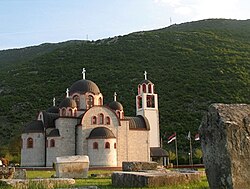Ljubinje
|
Ljubinje Љубиње |
||
|---|---|---|

Orthodox church in Ljubinje
|
||
|
||
 Location of Ljubinje within Bosnia and Herzegovina |
||
| Country | Bosnia and Herzegovina | |
| Entity | Republika Srpska | |
| Boroughs | 21 (2008.) | |
| Government | ||
| • Mayor | Darko Krunic (SDS) | |
| Area | ||
| • Total | 319,07 km2 (12,319 sq mi) | |
| Population (2013 census) | ||
| • Total | 3,756 | |
| • Density | 11,8/km2 (310/sq mi) | |
| Time zone | CET (UTC+1) | |
| • Summer (DST) | CEST (UTC+2) | |
| Area code(s) | 59 | |
Ljubinje (Serbian Cyrillic: Љубиње) is a town and municipality in Republika Srpska, Bosnia and Herzegovina. It is situated in south-eastern part of Herzegovina region.
In the antique period, a road ran from Narona to Epidaurum via Pardua, present day village Gradac, near Ljubinje. The remains of a Roman settlement have been identified near Ljubinje. No systematic expert investigations have ever been conducted in the area.
In the early mediaeval period the area of present-day Ljubinje municipality belonged to the large early mediaeval župa (county) of Popovo, constituting the northernmost part of Popovo county, bordering with the counties of Dubrave and Dabar. Politically, the area belonged to the Hum district, ruled from the 12th to almost the first half of the 14th century, with minor interruptions, by the Nemanjić's. From 1324 to 1326 this part of Hum was occupied by Bosnia's Ban Stjepan II Kotromanić, whose heir Tvrtko I had by 1373 extended the borders of the Bosnian state southwards to take in the whole of Hum. Tvrtko's reign saw the rise to power of the Kosača family, of whom Vlatko Vuković had already by that time begun to rule much of Hum;during Sandalj Hranić's (1392-1435)and Herceg Stjepan Vukčić Kosača's (1435-1466) time and that of the latters sons, until1482, Hum was entirely governed by the family.
The Ottomans occupied the area around Ljubinje between 1465 and 1467, and the census of the Bosnian sandžak for 1468/69 already included the nahija of Ljubinje.
Under article 29 of the Treaty of Berlin of 1878, Austria-Hungary received special rights in the Ottoman Empire's provinces of Bosnia-Herzegovina and the Sanjak of Novi Pazar. On 14 August 1878, Austro-Hungarian army marched in Ljubinje, ending Ottoman rule in the region. On 6 October 1908, Emperor Franz Joseph announced to the people of Bosnia-Herzegovina his intention to give them an autonomous and constitutional regime and the provinces were annexed. Bosnian annexation was not countenanced by the Treaty of Berlin and set off a flurry of diplomatic protests and discussions. Ljubinje remained part of the Austro-Hungarian Empire until the liberation at the end of World War I, when the Serbian army marched into Ljubinje.
...
Wikipedia

